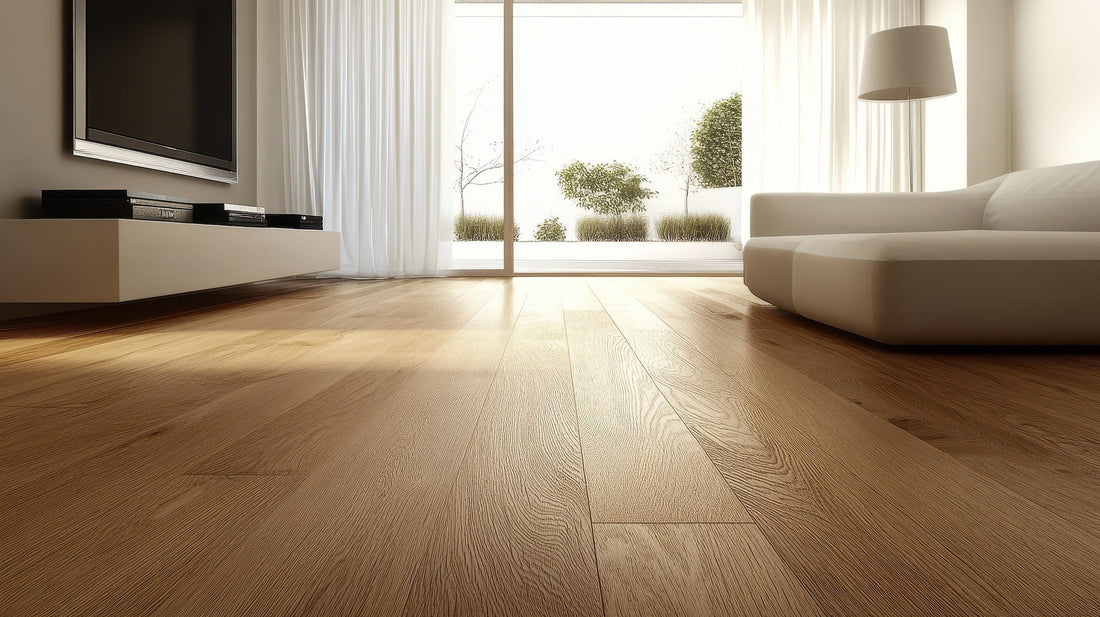
Chip-Free Laminate Floor Cutting Techniques
Share
Cutting laminate flooring doesn't have to be a daunting task. With the right techniques and tools, you can achieve chip-free cuts and a professional-looking installation.
Whether you are installing laminate in your kitchen, bathroom, a closet, a laundry room, bedroom or somewhere else in your home, you may have to cut your laminate and cut your laminate around a curve or tricky angle. Learn how to cut laminate flooring without chipping and around a curve with Flooring Attic, your laminate floor experts!
Understanding Laminate Flooring Composition
Before diving into cutting techniques, it's essential to understand the composition of laminate flooring. Laminate is typically made up of four layers:
Wear Layer: This transparent top layer protects the flooring from scratches, stains, and wear.
Decorative Layer: This layer provides the visual design, mimicking the look of wood, tile, or stone.
Core Layer: This layer, usually made of high-density fiberboard (HDF), provides stability and strength.
Backing Layer: This layer adds moisture resistance and stability.
When cutting laminate, the goal is to make a clean cut through all the layers without damaging the decorative surface or causing chipping.

What Should I Use to Cut My Laminate Flooring?
Choosing the right tools is crucial for achieving clean cuts and preventing chipping. Here are some essential tools for cutting laminate flooring:
Jigsaw: A jigsaw is a versatile tool that can make straight and curved cuts. Choose a jigsaw with a fine-tooth blade specifically designed for laminate flooring.
Circular Saw: A circular saw is ideal for making long, straight cuts. Use a blade with a high tooth count for smoother cuts.
Miter Saw: A miter saw is useful for making angled cuts, especially for corners and transitions.
Utility Knife: A sharp utility knife can be used for scoring and snapping laminate planks for simpler cuts.
Laminate Shears: These specialized shears are designed for making precise cuts in laminate flooring, especially for intricate shapes or curves.
Tips and Techniques for Cutting Laminate Flooring Without Chipping
Score & Snap for Straight Cuts
For straight cuts, you can often score the laminate with a utility knife and then snap the plank along the score line. This works best for thinner laminate planks.
Use a Fine-Tooth Jigsaw Blade
Use the Right Blade: Choose a fine-tooth jigsaw blade specifically designed for laminate flooring. This will minimize chipping and create a smoother cut.
Support the Laminate: Support the laminate plank firmly on both sides of the cut to prevent it from vibrating or flexing, which can cause chipping.
Cut from the Back: Whenever possible, cut laminate from the back side to minimize chipping on the decorative surface.
Control the Speed: Use a moderate speed setting on your jigsaw to avoid overheating the blade and causing chipping.
Use a Straight Edge Circle Saw
Use a Guide: Use a straight edge or a guide to ensure a straight and accurate cut.
Score the Cut Line: Score the cut line with a utility knife before using the circular saw. This helps prevent chipping along the edges.
Clamp the Laminate: Clamp the laminate securely to your work surface to prevent movement during cutting.
How to Cut Laminate Flooring Around a Curve
Use a Jigsaw: A jigsaw is the best tool for cutting curves in laminate flooring. Choose a blade with a narrow profile for tighter curves.
Mark the Curve: Carefully mark the curve on the laminate plank using a pencil or a template.
Make Relief Cuts: For tight curves, make relief cuts along the curve with the jigsaw. This will make it easier to navigate the curve and prevent chipping.
Go Slow: Cut slowly and carefully along the curve, following your marked line.
Tips to Prevent Chipping
Sharp Blades: Always use sharp blades to minimize chipping. Replace dull blades promptly.
Masking Tape: Apply masking tape along the cut line to help prevent chipping, especially when using a circular saw.
Reverse Cutting: When using a jigsaw, consider cutting in reverse (with the blade moving upwards) to minimize chipping on the decorative surface.
Additional Floor Cutting Questions
Can you curve or bend laminate flooring?
No, you cannot curve or bend traditional laminate flooring. It is designed to be installed in a straight, linear fashion. Attempting to bend laminate planks can cause them to crack or break.
Do you cut laminate flooring face up or down?
It's generally recommended to cut laminate flooring face down. This helps prevent chipping or splintering of the decorative surface layer. When cutting face down, the saw blade teeth cut into the backing of the plank, leaving a cleaner edge on the visible surface.
However, always refer to the manufacturer's instructions for your specific laminate flooring product, as some may have different recommendations.
Do you cut the tongue off the first row of laminate?
Yes, you typically need to remove the tongue on the first row of laminate flooring. This allows the planks to sit flush against the wall, creating a clean and even starting point for your installation. Use a utility knife or saw to carefully trim off the tongue, ensuring a smooth edge for a seamless look.
Order Your Laminate & Install it Anywhere with Our Tips!
Cutting laminate flooring without chipping requires the right tools, techniques, and a bit of practice. By following these tips and using the appropriate cutting methods for different shapes and curves, you can achieve a clean and professional-looking installation that enhances the beauty of your new laminate floor.
Give Flooring Attic a call to explore our wide selection of laminate flooring options and discuss your flooring needs. With 14 locations and over 39 years of experience, Atlanta Flooring Design Centers (our parent company) is a Top 10 Independent Flooring Retailer, dedicated to providing exceptional service and expertise to homeowners.
Our knowledgeable team can guide you through the selection process, offer valuable advice on installation techniques, and help you choose the perfect laminate flooring to enhance your home's style and functionality.
